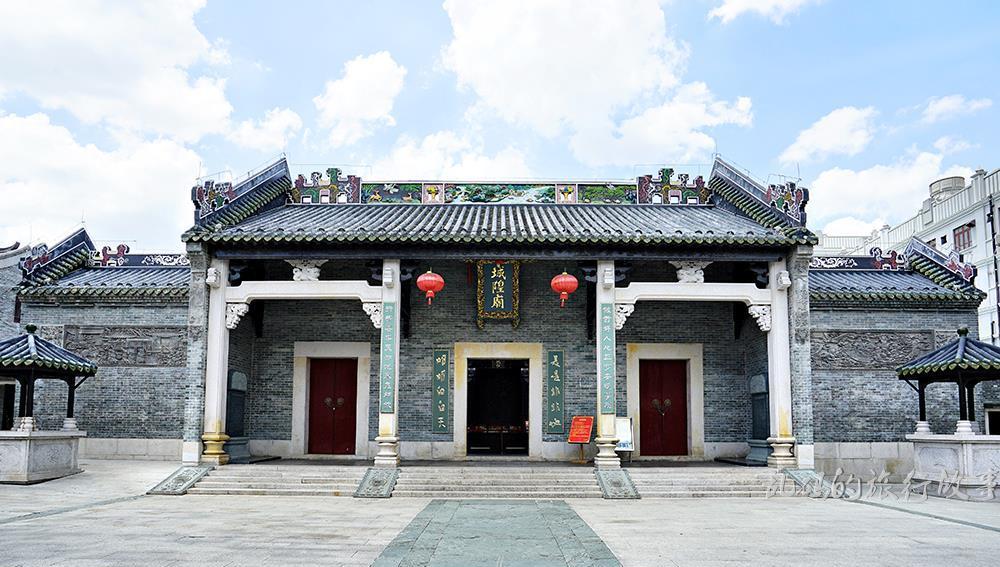
Many outsiders know the landscape of Guilin, Guangxi, but they do not know that the capital of Guangxi is Nanning. Because they only know from geography books that Nanning is located on the border, this misunderstanding makes Nanning seem to lack cultural heritage. In fact, this ancient city with a history of nearly 1700 years has a long history and has produced many awe-inspiring historical figures.
"Three streets and two alleys", is the most representative of Nanning's historical district, by Xingning Road, Minsheng Road and Jiefang Road three old streets, Golden Lion Lane and Silver Lion Lane two Ming and Qing ancient alleys, the block has the only preserved Qing Dynasty to the Republic of China period of residential groups in Nanning City, and located in the center of the block is a city god temple built in the Song Dynasty.
In ancient times, all those who had a city had a city god temple. The city god enshrined in the City God Temple is the protective deity of the city in Chinese Taoism, and most of them have their own people in history. Since the Song Dynasty, the imperial court has enshrined loyal martyrs who protect the country and the people as the gods of the city. The Nanning City God Temple is dedicated to a famous person in the history of Nanning, Su Xuan, so it is also known as the Su Xuan City God Temple.
During the Northern Song Dynasty, due to the emphasis on border defense between the north and the south, it was possible to give way to the cross-toe in present-day northern Vietnam. In the eighth year of Song Yaning (1075), Li Changjie, the lieutenant of Jiaotong, led an army of more than 100,000 troops to Yongzhou (Nanning), while only more than 2,000 defenders were stationed in Yongzhou at that time. In the face of the 100,000 heavy troops who were oppressive, Su Xuan, who was then the governor of Yongzhou, did not waver and led the entire army and people of the city to hold the city.
Su Xuan (1016~1076), a jinshi during the Reign of Emperor Renzong of Song and the cousin of the Northern Song dynasty scientist Su Song, once defeated Nong Zhigao, the "Emperor of the Great Southern Kingdom" of Yongzhou, together with Di Qing, and made great military achievements. After holding the city for 42 days, he finally lost foreign aid and ran out of grain, leading his family to martyrdom. In the ninth year of Song Xining (1076), after Di Qingbu recaptured Guo Kui and buried the bones of Su Xuan's entire family under the city wall of Yongzhou.
After Su Xuan's heroic martyrdom, Emperor Shenzong of Song posthumously awarded Su Xuan the title of "Envoy of the Fengguo Army" and "Loyal and Courageous". Later, when the city of Yongzhou was rebuilt, the local people built a shrine to sacrifice at the place of Su Xuan's martyrdom, named "Su Zhongyong Ancestral Hall". In the Southern Song Dynasty, the Su Zhongyong Ancestral Hall was gradually transformed into the Fucheng God Temple, and Su Zhongyong was enshrined as the Yongzhou City God. When the City God Temple was rebuilt in the 38th year of the Ming Dynasty, a side hall was built in addition to the main hall to enshrine the city god of the four counties of Nanning.
With the passage of time, the Nanning City God Temple, which has been eroded by wind and rain for hundreds of years, has become dilapidated. In the eighth year of the Republic of China (1919), the City God Temple was rebuilt into the Nanning Trial and Procuratorate Offices, and in the early days of the founding of New China, it was rebuilt as the Red Star Theater. In order to commemorate Su Xuan, the local people built a small shrine on the nearby high hill to enshrine the statue of Su Xuan, and the incense has been continuous.
In 2017, Nanning City decided to rebuild the Nanning City God Temple on the original site. The reconstructed City God Temple covers an area of 3605.26 square meters, consisting of a mountain gate, a city god hall, a sleeping hall, an east-west room, and an east-west matching room, which is the traditional architectural style of Lingnan in the Ming and Qing dynasties. The exhibition in the temple introduces Su Xuan's life deeds, loyalty and courage, patriotic feelings and family style and family training. If you have the chance, you may as well come and take a walk around.